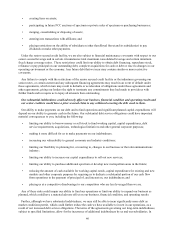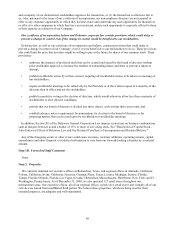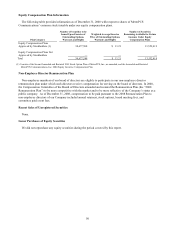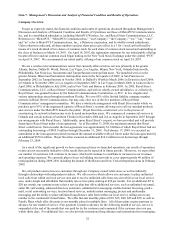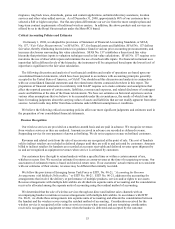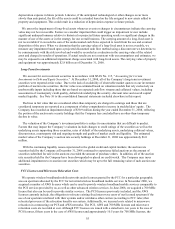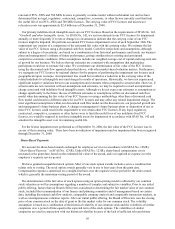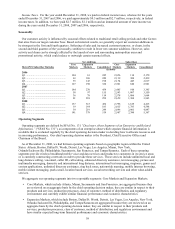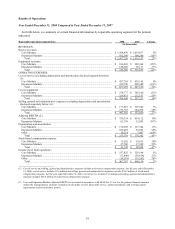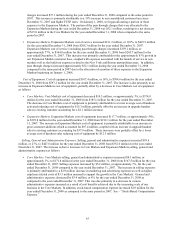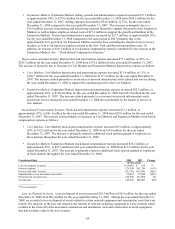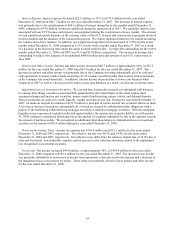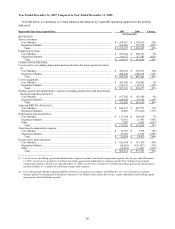Metro PCS 2008 Annual Report Download - page 65
Download and view the complete annual report
Please find page 65 of the 2008 Metro PCS annual report below. You can navigate through the pages in the report by either clicking on the pages listed below, or by using the keyword search tool below to find specific information within the annual report.56
renewal of PCS, AWS and 700 MHz licenses is generally a routine matter without substantial cost and we have
determined that no legal, regulatory, contractual, competitive, economic, or other factors currently exist that limit
the useful life of our PCS, AWS and 700 MHz licenses. The carrying value of FCC licenses and microwave
relocation costs was approximately $2.4 billion as of December 31, 2008.
Our primary indefinite-lived intangible assets are our FCC licenses. Based on the requirements of SFAS No. 142,
“Goodwill and other Intangible Assets,”or SFAS No. 142, we test investments in our FCC licenses for impairment
annually or more frequently if events or changes in circumstances indicate that the carrying value of our FCC
licenses might be impaired. We perform our annual FCC license impairment test as of each September 30th. The
impairment test consists of a comparison of the estimated fair value with the carrying value. We estimate the fair
value of our FCC licenses using a discounted cash flow model. Cash flow projections and assumptions, although
subject to a degree of uncertainty, are based on a combination of our historical performance and trends, our business
plans and management’s estimate of future performance, giving consideration to existing and anticipated
competitive economic conditions. Other assumptions include our weighted average cost of capital and long-term rate
of growth for our business. We believe that our estimates are consistent with assumptions that marketplace
participants would use to estimate fair value. We corroborate our determination of fair value of the FCC licenses,
using the discounted cash flow approach described above, with other market-based valuation metrics. Furthermore,
we segregate our FCC licenses by regional clusters for the purpose of performing the impairment test because each
geographical region is unique. An impairment loss would be recorded as a reduction in the carrying value of the
related indefinite-lived intangible asset and charged to results of operations. Historically, we have not experienced
significant negative variations between our assumptions and estimates when compared to actual results. However, if
actual results are not consistent with our assumptions and estimates, we may be required to record an impairment
charge associated with indefinite-lived intangible assets. Although we do not expect our estimates or assumptions to
change significantly in the future, the use of different estimates or assumptions within our discounted cash flow
model when determining the fair value of our FCC licenses or using a methodology other than a discounted cash
flow model could result in different values for our FCC licenses and may affect any related impairment charge. The
most significant assumptions within our discounted cash flow model are the discount rate, our projected growth rate
and management’s future business plans. A change in management’s future business plans or disposition of one or
more FCC licenses could result in the requirement to test certain other FCC licenses. If any legal, regulatory,
contractual, competitive, economic or other factors were to limit the useful lives of our indefinite-lived FCC
licenses, we would be required to test these intangible assets for impairment in accordance with SFAS No. 142 and
amortize the intangible asset over its remaining useful life.
For the license impairment test performed as of September 30, 2008, the fair value of the FCC licenses was in
excess of their carrying value. There have been no indicators of impairment and no impairment has been recognized
through December 31, 2008.
Share-Based Payments
We account for share-based awards exchanged for employee services in accordance with SFAS No. 123(R),
“Share-Based Payment,” or SFAS No. 123(R). Under SFAS No. 123(R), share-based compensation cost is
measured at the grant date, based on the estimated fair value of the award, and is recognized as expense over the
employee’s requisite service period.
We have granted nonqualified stock options. Most of our stock option awards include a service condition that
relates only to vesting. The stock option awards generally vest in one to four years from the grant date.
Compensation expense is amortized on a straight-line basis over the requisite service period for the entire award,
which is generally the maximum vesting period of the award.
The determination of the fair value of stock options using an option-pricing model is affected by our common
stock valuation as well as assumptions regarding a number of complex and subjective variables. Prior to our initial
public offering, factors that our Board of Directors considered in determining the fair market value of our common
stock, included the recommendation of our finance and planning committee and of management based on certain
data, including discounted cash flow analysis, comparable company analysis and comparable transaction analysis, as
well as contemporaneous valuation reports. After our initial public offering, the Board of Directors uses the closing
price of our common stock on the date of grant as the fair market value for our common stock. The volatility
assumption is based on a combination of the historical volatility of our common stock and the volatilities of similar
companies over a period of time equal to the expected term of the stock options. The volatilities of similar
companies are used in conjunction with our historical volatility because of the lack of sufficient relevant history


